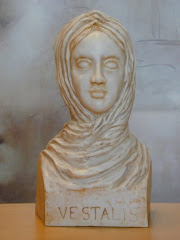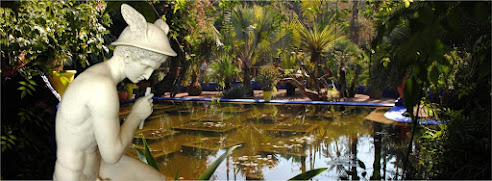The Veiled Vestal by Raffaele Monti
 |
| Bust of Veiled Vestal |
Bust of the Veiled Vestal
This faithful reproduction of Raffaele Monti's bust of the
Veiled Vestal is handmade in our workshops in molded marble (marble dust bonded
with resins). Its exquisite finish and the application of aging patinas made
from natural earth give it the appearance of a marble statue beautified by the
passage of time, making it ideal for decorating outdoor spaces such as gardens,
patios, and terraces, as it can withstand exposure to the elements.
The measurements of this reproduction are 53 cm in height
and 27 cm in width (total measurements of the bust plus the base), making them
ideal for placing on a pedestal.
You can purchase the bust at the following link:
_at_Chatsworth_House%20(1).jpg) |
The Veiled Vestal Virgin (Raffaelle Monti) at Chatsworth House.JPG by Sophie234 under CC BY-SA 3.0 |
In this reproduction we recreate an original work by the 19th-century Italian artist Raffaele Monti, who gained fame in his time for his skill in portraying veiled figures with special subtlety and delicacy.
The original sculpture is a full-body statue of a kneeling
Vestal holding a plate with the flame of Vesta between her hands. It was
sculpted by Raffaele Monti on commission from the Duke of Devonshire between
1846 and 1847 and can be admired today in one of the Devonshire family's
properties, Chatsworth House, Derbyshire, England.
_Dama_Velata_(1845).jpg) |
| Raffaele Monti (1818-1881) Dama Velata (1845).jpg by Paolobon140 under CC BY 4.0 |
From this statue, a bust was created and is currently exhibited in the Racconigi Castle in Piedmont, Italy. The priestess's headdress stands out, with a crown of flowers over her head, the veil covering her face. The meticulousness of the marble work, especially in the folds that suggest the face beneath, gives the impression of a fine, transparent fabric.
Raffaele Monti
The author of this work, Raffaele Monti, was born in 1818 in
Milan, which was part of the Austrian Empire at the time, and died in London in
1881. He showed exceptional talent in sculpture from a young age and studied at
the Royal Imperial Academy of Fine Arts in Milan, which awarded him a medal.
This distinction opened doors for him to work with institutions in other
countries: he was first invited to Vienna and later to Budapest, where he
worked at the National Museum of Hungary. He returned to Milan in 1842 and four
years later received a commission from the Duke of Devonshire to sculpt the
Vestal. Between 1846 and 1847, he worked on this piece in England. After the
outbreak of the Italian revolution, Monti returned to Milan to join the
uprising. In 1848, following the failure of the uprisings, he returned to
England, where he would reside until the end of his days.
Monti gained some fame in England, and at the Great
Exhibition of the Crystal Palace, he exhibited several of his works, including
the Veiled Vestal, which received general acclaim from the public, although the
award ultimately went to another work, "Eve after the Fall."
Despite the fame he achieved among his contemporaries,
Raffaele Monti died in 1881 in impoverished conditions.
The Vestals in Rome
In this work, the artist recreated the figure of a Vestal, a
priestess of Ancient Rome. Monti depicted her with a veil, kneeling, and
holding a plate with the Sacred Fire in an offering gesture. In neoclassical
art, figures from Classical Antiquity were represented, not only mythological
characters or great historical personalities but also everyday life, where
artists poured all their knowledge of working with marble to reproduce in hard
stone the textures of fabrics, delicate veils, and folds. Hence, the preference
of neoclassical sculptors for veiled figures like the Vestals, where they could
showcase their technical perfection and sensitivity.
.jpg) |
| Statue of a Vestal Virgin (49350431033).jpg by Jamie Heath under CC BY-SA 2.0 |
The Vestals, "virgines vestales" in Latin, were the guardians of Rome's sacred fire, which was kept by this female priestly college in the circular temple of Vesta sited in the Forum, the ruins of which can be visited nowadays. Symbols of purity and the city's continuity, these virgin priestesses played a fundamental role in Roman religion, and their legacy endures today as an example of devotion, service, and dedication.
The Vestals formed a college of priestesses dedicated to the
service of the goddess Vesta, the divine guardian of the home and sacred fire.
The institution of the Vestals dates back to the early days of Rome, appearing
in its mythical origins, in the figure of Rhea Silvia, the mother of Rome's
founders, the twins Romulus and Remus. According to myth, Rhea Silvia was a
Vestal who conceived her children with the god Mars, breaking her vow of
chastity.
The primary duty of the Vestals was to keep the eternal
flame burning in the temple of Vesta. This fire was considered a symbol of
divine protection over the city and its continuity. In all Roman households,
there was an equivalent domestic version at the household altar or lararium,
and matrons were responsible for keeping a flame or lamp perpetually lit.
The Vestals were selected as young girls from patrician
families and had to meet certain requirements to be considered candidates, such
as being born of a legitimate marriage and not having any obvious physical
defects. The final selection was made through a special ritual in which the six
candidates became Vestals.
From that moment on, the Vestal was devoted to the goddess
and had to remain chaste during the thirty years of her priesthood, divided
into three ten-year stages. In the first ten years, the young Vestal had to
learn the rituals and religious duties assigned to her, under the guidance of
an older priestess. In the next ten years, they carried out their
responsibilities in the temple of Vesta, and in the final ten years, they
dedicated themselves to teaching a new generation of Vestals.
Vestals, their responsibilities and their legacy
A fundamental requirement for the Vestals was to maintain chastity, breaking the vow of celibacy was unforgivable and punishable by death. It was believed that any impurity in the priestesses would taint the purity of the Sacred Fire and, therefore, endanger the safety of Rome. Despite this, the Vestals enjoyed a special status in Roman society and were endowed with certain rights that contrasted with the situation of other Roman women, such as not needing a male guardian and being able to act in their own name in certain legal transactions and certain procedures, such as the right to make a will.
The primary responsibility of the Vestals was to keep the
sacred fire of Vesta burning. This fire could not be extinguished under any
circumstances, and its extinction was considered a harbinger of disaster for
Rome. On the occasions when it did go out, after consulting the Senate, the
fire was reignited. To preserve its purity, the fire was kindled using
sunlight, employing a convex mirror to concentrate solar rays.
In addition to tending the Sacred Fire, the Vestals also had
a role in protecting the sacred objects stored in the temple and participated
in religious rituals. The High Priestess was the Virgo Vestalis Maxima, the
highest-ranking priestess in Roman religion, who presided over ceremonies in
honor of Vesta and had a place of honor in ceremonies for other Roman gods and
other important events.
The Vestals enjoyed great importance in Roman religion,
although over time, their significance in society diminished, and their
privileges were reduced. As Christianity spread throughout the Roman Empire,
ancient Roman religion lost influence. The Vestals ultimately disappeared along
with the other non-Christian cults due to an edict by Emperor Theodosius, and
the closure of the Temple of Vesta in Rome took place in AD 391. (Just two
decades later, in 410, the Visigothic king Alaric entered Rome and sacked it,
marking the beginning of the fall of the Western Roman Empire.)
 |
| Bust of Veiled Vestal |
With this sculpture we remind the Ancient Rome, its art and
its values. The Vestals, guardians of the sacred fire, illuminated Rome's
history with their dedication and service, and they symbolize the deep connection between the divine and
our earthly world.
You can get this opportunity and turn your home into a space
that recalls the values and beauty of the classical world with art
reproductions like this bust of the Veiled Vestal.
Purchase this sculpture in our online shop: https://www.decorarconarte.com/en/p/virgen-vestal-velada-53-cm/
Other sculptures of vestals in our catalog:
Veiled Vestal. 33 cm. Gilded.
Veiled Vestal. 37 cm.
Veiled Vestal. 33 cm.








Comments
Post a Comment